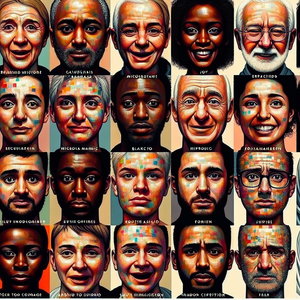Building a Remote UX Portfolio: Tips for Entry-Level Designers

One of the key aspects of a compelling UX portfolio is demonstrating a range of projects that reflect various facets of UX design. A portfolio that includes user research, wireframing, prototyping, and usability testing showcases your comprehensive understanding of the UX process. For example, if you’ve worked on a mobile app and a website redesign, include both to illustrate your versatility.
Diversity of Work
For those without extensive professional experience, it's essential to include projects that demonstrate practical applications of your skills. Academic projects, personal experiments, or volunteer work can serve as valuable additions. For instance, redesigning a local nonprofit’s website not only highlights your design skills but also shows your commitment to making a positive impact in your community.
Personal Projects
Including personal projects in your portfolio can be a game-changer. These projects often reflect your passions or interests and demonstrate your initiative and creativity. For example, if you are passionate about environmental sustainability, a project that involves designing an app to promote eco-friendly practices can resonate with potential employers and set you apart from other candidates.
Presenting Case Studies
Each project in your portfolio should be framed as a case study that tells a cohesive story. Start with a clear problem statement, followed by your research process, design solutions, and the outcomes. For instance, if you redesigned a user interface, explain the pain points users faced, how you gathered feedback, and the specific design changes you implemented. This narrative approach allows potential employers to understand your thought process and the impact of your work.
Visuals Matter
High-quality visuals are crucial in enhancing your project presentations. Use clear screenshots, wireframes, and prototypes that are professionally displayed. Tools like Figma or Adobe XD enable you to create interactive prototypes that can be embedded directly into your portfolio. For instance, showcasing a before-and-after comparison of a website redesign can visually illustrate your design impact.
Highlight Your Role
When collaborating on projects, it’s essential to clarify your specific contributions. This not only demonstrates your ability to work in a team but also ensures your individual efforts are highlighted. For example, if you were responsible for conducting user interviews, make this clear in your case study to showcase your research skills.
Using Design Tools to Enhance Appeal
The design of your portfolio should reflect your UX skills. Opt for a clean, easy-to-navigate layout that prioritizes user experience. A cluttered or confusing site can detract from the quality of your work. Consider using platforms like Behance or personal websites created with tools such as WordPress or Squarespace, which offer templates that prioritize simplicity and clarity.
Interactive Elements
Incorporating interactive elements can significantly enhance user engagement with your portfolio. Clickable prototypes, animations, or hover effects can guide users through your projects more dynamically. For example, allowing potential employers to interact with a prototype directly can provide them with a hands-on understanding of your design approach.
Mobile Responsiveness
With many recruiters likely to view your portfolio on mobile devices, ensuring your site is mobile-responsive is critical. Test your portfolio on various screen sizes to ensure it looks and functions well across devices. A seamless mobile experience reflects your understanding of UX principles and shows that you value user experience in every context.
Building a remote UX portfolio as an entry-level designer presents both challenges and opportunities. By selecting a diverse array of relevant projects, effectively presenting them through compelling case studies, and leveraging effective design tools and principles, you can create a portfolio that stands out in a crowded job market. Remember, your portfolio is not merely a collection of your work; it’s a reflection of your identity as a designer. By investing time and effort into crafting a polished, engaging portfolio, you'll be well on your way to capturing the attention of potential employers in the burgeoning remote UX job market. Embrace this journey, and let your unique perspective shine through your work.
Junior UX Researcher
Tech startups, e-commerce platforms, consulting firms such as IDEO or Nielsen Norman Group
Core Responsibilities
Conduct user interviews and surveys to gather valuable insights on user behavior and preferences.
Analyze qualitative and quantitative data to inform design decisions and improve user experience.
Collaborate with UX designers and product teams to translate research findings into actionable design recommendations.
Required Skills
Strong analytical skills with experience in tools like Google Analytics and usability testing software.
Excellent communication abilities to present findings clearly to cross-functional teams.
Familiarity with research methodologies and user-centered design principles.
UI Designer for Mobile Applications
Mobile app development companies, gaming studios, large tech firms like Apple or Google
Core Responsibilities
Design intuitive and visually appealing user interfaces for mobile applications, ensuring alignment with brand guidelines.
Create interactive prototypes and wireframes to effectively communicate design concepts to stakeholders.
Collaborate with developers to ensure seamless implementation of design specifications.
Required Skills
Proficiency in design tools such as Figma, Sketch, or Adobe XD, with a strong portfolio showcasing mobile designs.
Understanding of mobile design principles and user interface patterns specific to iOS and Android.
Ability to work in an agile environment and adapt to changing project requirements.
Product Design Intern
Tech companies, startups, design agencies such as Frog Design or Fjord
Core Responsibilities
Assist in the design and prototyping of product features while contributing to the overall user experience.
Participate in user testing sessions to gather feedback and iterate on designs based on user insights.
Work closely with senior designers to support various stages of the design process, from ideation to final mockups.
Required Skills
Basic knowledge of design tools and software, with eagerness to learn and develop skills in UX/UI design.
Strong visual design sense and ability to create compelling user interfaces.
Good organizational skills and ability to manage multiple tasks in a fast-paced environment.
Interaction Designer
Software companies, product design firms, organizations with a focus on digital products such as Adobe or Microsoft
Core Responsibilities
Develop user interaction models and workflows that align with user needs and business goals.
Create wireframes, storyboards, and interactive prototypes to visualize design solutions.
Collaborate with UX researchers to validate design decisions through user testing and feedback loops.
Required Skills
Solid understanding of interaction design principles and usability best practices.
Proficiency in prototyping tools like InVision or Axure, and familiarity with HTML/CSS is a plus.
Strong problem-solving skills and ability to think critically about user interactions.
Visual Designer
Advertising agencies, media companies, tech firms such as Facebook or Amazon
Core Responsibilities
Create visually engaging graphics and layouts for websites, applications, and marketing materials.
Collaborate with UX designers to ensure visual elements align with user experience goals and brand identity.
Stay updated on design trends and best practices to continually enhance the visual impact of projects.
Required Skills
Proficiency in graphic design software such as Adobe Creative Suite (Photoshop, Illustrator, etc.) and a strong portfolio demonstrating visual design work.
Understanding of typography, color theory, and layout principles.
Ability to communicate design concepts effectively and work collaboratively in a team environment.


